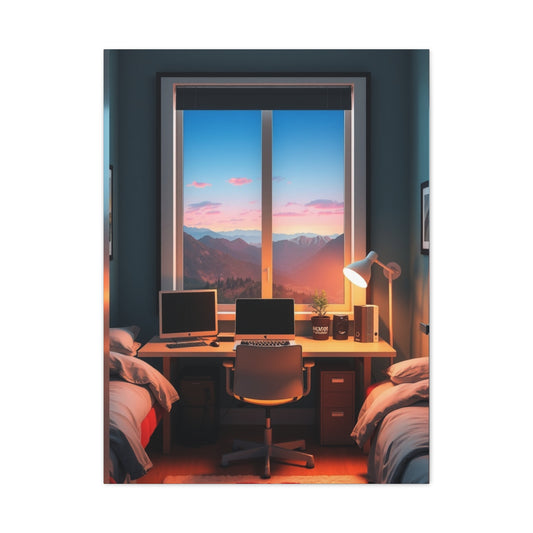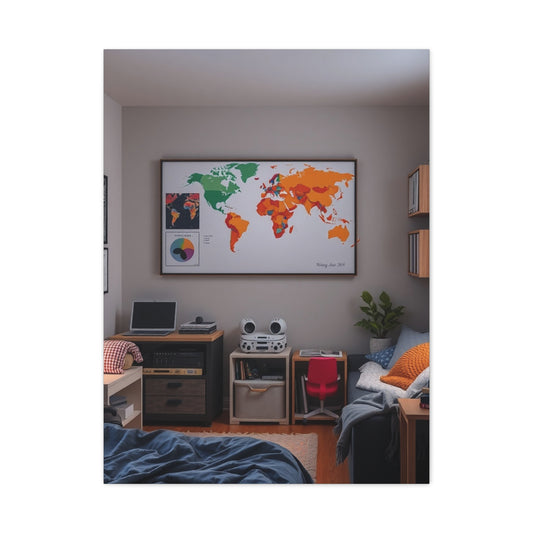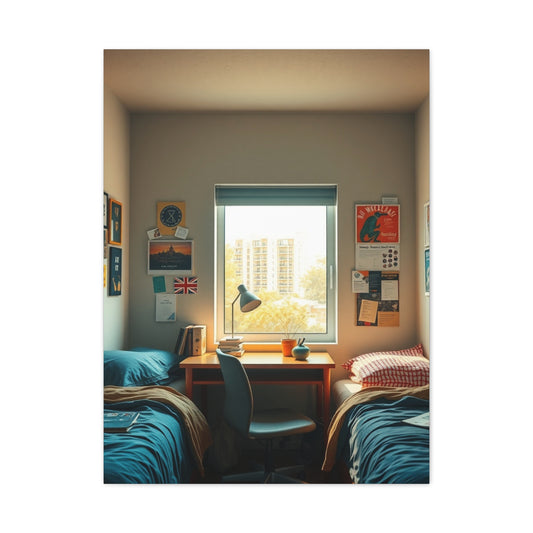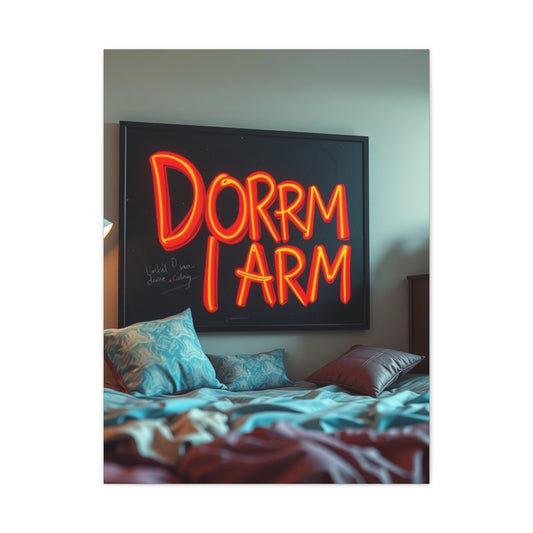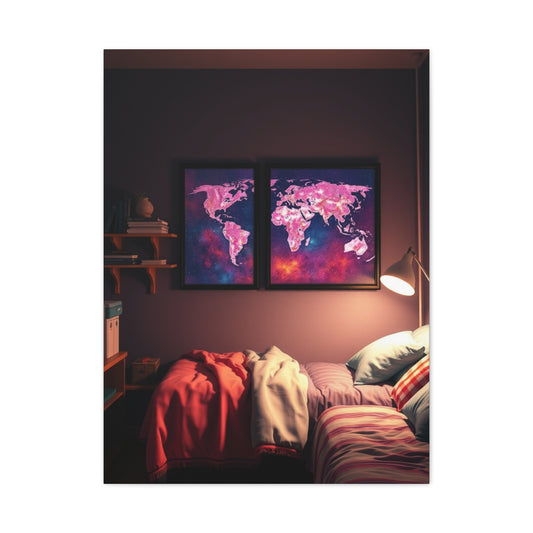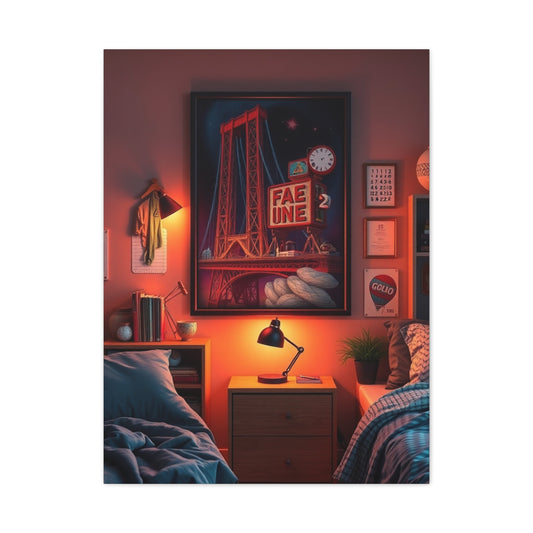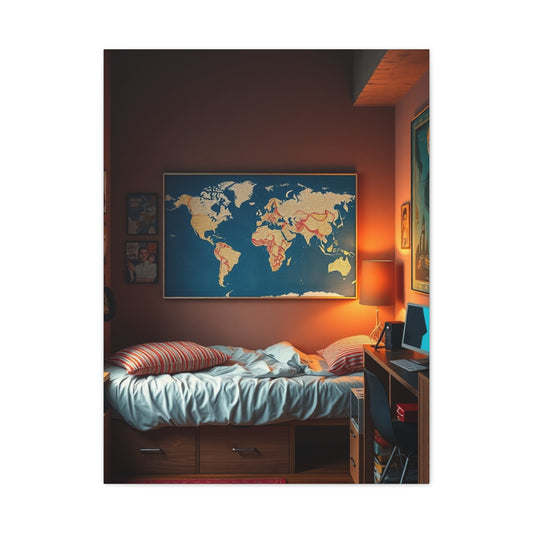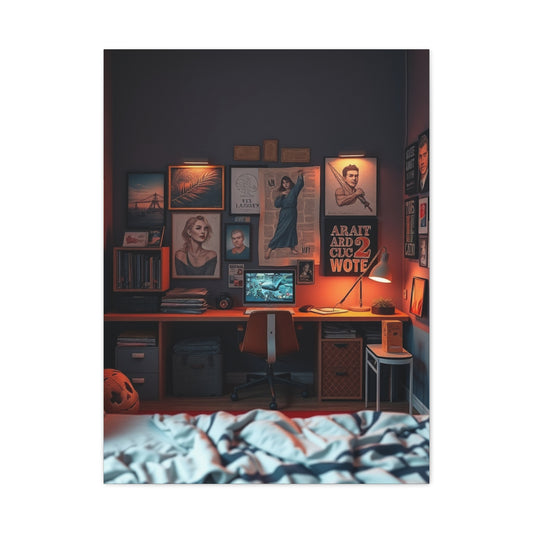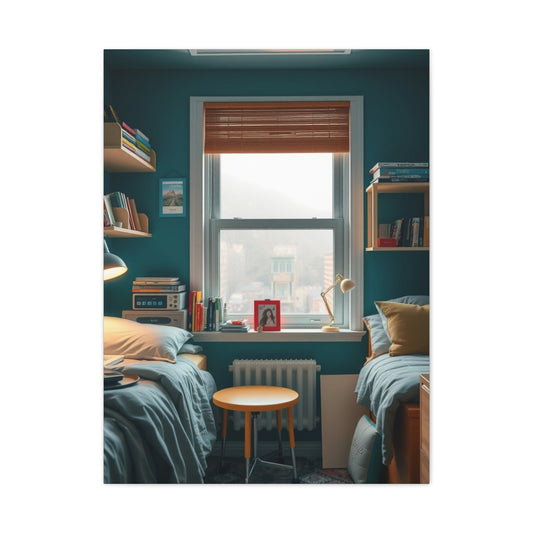Personalize Your Dorm with Fun and Functional Dorm Wall Art
Transitioning to college life can be exhilarating, but it often comes with a fair share of homesickness and adjustment challenges. One of the most effective ways to ease this transition is by transforming a dorm room into a comfortable and personalized sanctuary. Dorm rooms are usually compact and multifunctional, serving as a bedroom, study space, and social hub all at once. Therefore, creating an environment that is both visually stimulating and emotionally comforting can have a profound impact on one’s overall wellbeing and productivity.
A cozy dorm environment is not merely about aesthetics; it’s about curating a space that resonates with your personality and fosters a sense of belonging. The walls of a dorm room, in particular, offer immense potential for self-expression. Though most student housing policies prohibit permanent alterations like nails or screws in the wall, numerous non-invasive alternatives exist. By using removable materials and clever decorative strategies, students can transform plain, utilitarian walls into vibrant canvases that reflect their identity, passions, and inspirations.
Before diving into specific ideas, it is essential to understand the psychological impact of wall decor. Research in environmental psychology suggests that personalizing one’s space contributes to emotional comfort and reduces stress. Dorms that feature personal mementos, colors that evoke positive emotions, and visually appealing textures tend to feel more like home, which can help mitigate homesickness during the early weeks of college life.
Tapestries: Large-Scale Art for Your Walls
One of the simplest yet most effective ways to enhance a dorm room is by using tapestries. Tapestries can transform a bland wall into a statement piece without requiring permanent fixtures. Modern adhesive hooks and removable wall strips make it possible to hang a large piece of fabric safely and securely. These textiles can act as visual anchors in a room, providing both color and texture that complement other elements of the decor.
When selecting a tapestry, consider the mood or aesthetic you wish to cultivate. Mandala patterns evoke a sense of calm and balance, while tie-dye designs can create a vibrant, bohemian atmosphere. Some students choose tapestries that feature motivational quotes, iconic artwork, or favorite movie characters, allowing them to express individuality while creating a comforting focal point. The sheer versatility of tapestries means they can also serve functional purposes, such as covering unattractive wall patches or serving as a lightweight backdrop for study areas.
Layering tapestries with other elements like string lights or small wall-mounted shelves can elevate their effect. For instance, placing soft fairy lights along the perimeter of a tapestry adds warmth and subtle illumination, creating an inviting atmosphere conducive to both relaxation and study. Choosing complementary textures—like pairing a soft, flowing tapestry with metallic or wooden decorative elements—can enhance the room’s depth and make the space feel more sophisticated despite its limited square footage.
Removable Wallpaper: Transformative and Temporary
Peel-and-stick wallpaper has emerged as a popular solution for students seeking to add character to temporary living spaces. Unlike traditional wallpaper, removable designs are non-permanent, easily repositionable, and do not damage the underlying surface. This flexibility allows students to experiment with bold patterns, intricate textures, or whimsical graphics without long-term commitment.
The visual possibilities with removable wallpaper are nearly limitless. A wall adorned with geometric designs can introduce a modern, intellectual vibe, while floral motifs or vintage prints can infuse warmth and nostalgia. Some wallpapers simulate the appearance of natural materials such as brick, wood, or marble, providing a sense of texture and depth that can make a small dorm room feel more expansive.
Applying removable wallpaper successfully requires careful planning. Students often measure wall dimensions and cut panels in advance to ensure alignment, particularly with intricate patterns. Some prefer to apply wallpaper to only a single accent wall, creating a focal point without overwhelming the entire room. By pairing wallpaper with complementary decor elements such as framed photos, small shelves, or fabric accents, students can achieve a cohesive and visually harmonious environment.
Photo Displays: Capturing Memories on the Wall
Homesickness is a common challenge for students living away from family and familiar surroundings for the first time. One of the most effective ways to combat this feeling is by displaying images that evoke fond memories. Photo collages and personalized displays allow students to keep loved ones close while also adding a dynamic and personal touch to their dorm decor.
A variety of display methods exist for organizing photos. Some students opt for traditional collages, arranging pictures in artistic clusters on poster boards. Others prefer a more structured approach, creating a gallery wall with evenly sized photos aligned in grids. Lightweight adhesives, removable tack, or small clips allow for easy installation without damaging the walls. For a casual, playful aesthetic, photos can also be strung along a cord with tiny clothespins, creating a rotating gallery that can be updated throughout the year.
In addition to traditional photos, students can incorporate other small, flat mementos into their displays. Ticket stubs, postcards, or pressed flowers can add layers of texture and storytelling, making the wall a visual diary of personal experiences. This type of personalized decor serves both an emotional and aesthetic purpose: it creates a comforting sense of familiarity while enhancing the visual appeal of the space.
String Lights: Ambiance and Warmth
String lights are a simple yet transformative addition to any dorm room. Their gentle glow creates a warm, inviting ambiance that makes the space feel more intimate and relaxing. Beyond their functional role as supplemental lighting, string lights can serve as an artistic element, framing furniture, hanging over tapestries, or outlining wall patterns.
To add uniqueness, consider exploring nontraditional string light designs. Shapes like stars, moons, or geometric forms, as well as colored or multicolor strands, can elevate the visual interest of a room. Strategically placing string lights behind furniture, along shelves, or across wall borders can generate a layered lighting effect that enhances both comfort and style. The versatility of string lights allows them to adapt to various room configurations, making them an essential tool for dorm decorating.
Memorabilia: Transforming Memories into Decor
Throughout high school and personal life, many students accumulate memorabilia such as posters, varsity letters, yearbooks, concert tickets, or small keepsakes from family and friends. Rather than storing these items away, incorporating them into dorm decor adds a deeply personal dimension to the room. Displaying memorabilia transforms otherwise mundane walls into spaces that tell a story, reflecting one’s journey and achievements.
Certain items, like varsity letters or special awards, benefit from protective display. Shadow boxes or small display frames provide a secure way to showcase cherished items while keeping them safe from wear or damage. Other memorabilia, such as photographs or posters, can be arranged in visually compelling collages or layered alongside other decorative elements. By integrating meaningful items into the decor, students cultivate a living space that is uniquely theirs while simultaneously preserving treasured memories.
Dry-Erase Boards: Functional Creativity
Dry-erase boards offer a perfect combination of utility and decoration. These boards can serve as a central hub for organizing daily tasks, tracking assignments, leaving messages for roommates, or expressing creativity through doodles and sketches. Their versatility makes them an essential addition to a shared living environment, helping students maintain both structure and personalization.
Modern dry-erase boards can be installed without nails using adhesive strips or hooks, which keeps them compliant with dorm rules. Some students even create modular arrangements, combining multiple boards or incorporating additional elements such as cork strips, small shelves, or magnetic sections. This approach allows for multifunctional organization while simultaneously enhancing wall aesthetics.
Plants and Greenery: Nature in a Dorm Room
Adding greenery is a proven method to increase well-being, improve mood, and enhance the visual appeal of a space. Small indoor plants are especially suitable for dorm rooms, where floor space is limited. Low-maintenance options such as pothos, snake plants, aloe vera, or ZZ plants thrive in indirect sunlight and require minimal care, making them ideal companions for busy students.
Plants can be displayed in numerous creative ways. Hanging planters, stick-on shelves, or small containers on desks and windowsills provide vertical interest and prevent clutter. Integrating greenery into dorm decor not only softens the harsh lines of furniture and walls but also introduces a sense of tranquility and vitality, creating a more inviting atmosphere for both study and relaxation.
Light-Up Signs: Vibrancy and Personality
Light-up signs, including battery-operated neon and LED variants, are a playful addition to dorm walls. These signs add vibrancy and a dynamic focal point, allowing students to highlight favorite quotes, symbols, or even abstract designs. The luminous glow adds an element of nightlife ambiance, making the space feel lively and expressive.
Installing these signs is simple and dorm-compliant, as battery-operated models eliminate the need for extensive wiring or permanent fixtures. Strategically pairing light-up signs with tapestries, posters, or other wall decor can create a layered and visually engaging environment that reflects personality while providing aesthetic illumination.
Cork Boards: Practical and Personalized
Cork boards are a timeless solution for combining organization and decoration in a dorm room. These boards offer a versatile surface for pinning reminders, schedules, photos, and small memorabilia. The tactile and visual nature of cork allows students to interact with their wall decor in a dynamic way, creating a constantly evolving display that reflects daily life, moods, and achievements.
A cork board can serve multiple functions depending on placement and design. For instance, placing a cork board near a study desk can create a hub for to-do lists, class schedules, and inspirational quotes. Alternatively, a wall-mounted cork board in a more social area of the room can display photos of friends, postcards, and keepsakes from home, fostering a sense of connection and comfort. Some students choose to use decorative push pins, patterned cork tiles, or even painted cork surfaces to elevate the aesthetic impact of the board.
Beyond utility, cork boards can also be a platform for experimentation with visual composition. By arranging photos, tickets, or small notes in geometric patterns or artistic clusters, the board becomes more than just an organizational tool—it becomes a statement piece that conveys creativity and personal style. This blending of function and design makes cork boards a staple in dorm room decoration strategies.
Posters: Expression and Inspiration
Posters remain one of the most accessible and impactful ways to personalize a dorm room. They allow students to showcase their interests, passions, and inspirations while transforming blank walls into expressive canvases. Posters can depict scenes from favorite films, musical icons, athletes, or renowned art pieces, adding visual diversity and narrative depth to the space.
While posters may appear simple, strategic placement can dramatically affect the room’s ambiance. For example, grouping several posters into a gallery-style arrangement creates cohesion, while placing a large, bold poster above the bed or study area establishes a visual focal point. Frames, adhesive corners, or lightweight clips can protect the posters while maintaining dorm-appropriate compliance.
The selection of posters can also influence the emotional tone of the room. Bright, colorful posters can inject energy and optimism, while minimalist or monochrome prints can cultivate a sense of calm and sophistication. Combining posters with other decor elements—such as tapestries, string lights, or small shelves—can enhance depth, creating an environment that is both aesthetically appealing and psychologically comforting.
Keepsake Shadow Boxes: Preserving Memories
Keepsake shadow boxes are an elegant solution for organizing and displaying meaningful memorabilia collected over the course of life and high school. These boxes offer a three-dimensional space where items such as tickets, small gifts, medals, or photographs can be preserved and exhibited without taking up excessive space.
Shadow boxes allow students to maintain a tangible connection to important memories while integrating them into their room’s visual narrative. The arrangement of items within the box can reflect personal storytelling, highlighting milestones, achievements, or cherished moments. For instance, a shadow box could include a small memento from a first concert, a ticket from a memorable sporting event, and a photograph of friends, creating a microcosm of life experiences within a single display.
Placement is flexible. Shadow boxes can be positioned on a desk, dresser, or stick-on wall shelf, ensuring that precious items are both visible and protected. The design possibilities are also abundant: combining various shapes, sizes, and materials of boxes can add a sculptural element to the wall while maintaining dorm-appropriate compliance.
Removable Stickers: Flexible Creativity
Removable wall stickers or decals are a versatile and playful approach to personalizing dorm walls. They are available in a wide array of styles, from abstract designs and motivational quotes to pop culture icons and botanical motifs. Their non-permanent nature makes them ideal for temporary spaces, allowing students to experiment with different layouts and combinations without risking wall damage.
One of the advantages of removable stickers is their adaptability. They can be used to fill empty wall space, accentuate other decor elements like posters or cork boards, or create a thematic visual narrative throughout the room. Additionally, stickers can be layered or combined in patterns to produce a more complex and personalized effect, transforming a blank wall into an engaging visual statement.
Using wall decals strategically can also enhance spatial perception. For instance, vertical patterns or elongated shapes can create the illusion of taller ceilings, while clustered or repeating designs can make small areas feel more dynamic and lively. This combination of aesthetic appeal and spatial enhancement makes removable stickers a valuable tool in dorm decorating.
Painted Canvas: Personalized Wall Art
Creating wall art from scratch is a rewarding way for students to express creativity and imbue a dorm room with individuality. Painted canvases provide the freedom to experiment with color, texture, and style, producing artwork that resonates personally and adds a handcrafted dimension to the room.
Artistic approaches vary widely. Some students explore abstract techniques with bold brush strokes and contrasting colors, while others gravitate toward thematic or figurative painting, creating visual narratives that complement their personality or interests. Beyond traditional painting, mixed-media canvases incorporating collage elements, textured materials, or even subtle metallic accents can create depth and intrigue.
The placement of painted canvases is critical for impact. A large canvas positioned above a bed, desk, or main seating area serves as a focal point, drawing attention and setting the tone for the room. Smaller canvases can be grouped together to create miniature gallery walls, enhancing the sense of creativity and cohesion. This hands-on approach allows students to curate a space that is not only visually stimulating but also deeply personal.
Layering Decor: Combining Elements
Effective dorm wall decoration often involves layering multiple elements to achieve a cohesive and multidimensional effect. Combining tapestries, string lights, posters, cork boards, and painted canvases can create a visually rich environment that reflects personality and maximizes limited wall space.
For example, a tapestry can serve as a central backdrop, with a series of string lights draped along its edges for soft illumination. A cork board or shadow box can be positioned adjacent to the tapestry, offering both organizational utility and visual interest. Smaller decorative items, such as posters, stickers, or painted canvases, can fill remaining wall space, creating balance and rhythm throughout the room.
Layering decor also allows students to experiment with visual storytelling. By thoughtfully arranging elements that reflect personal history, interests, or aspirations, the room becomes more than a living space—it transforms into an immersive environment that nurtures comfort, motivation, and self-expression. This method emphasizes intentionality, encouraging students to consider the interplay of colors, textures, and forms to achieve harmony and aesthetic impact.
The Role of Color and Texture
Color and texture are fundamental considerations when designing a dorm room. Colors influence mood, perception, and emotional response, while textures add depth and tactile interest. Understanding how these elements interact can enhance the effectiveness of wall decor and overall spatial design.
Warm tones, such as soft oranges, deep reds, or golden yellows, can evoke energy and coziness, making a room feel welcoming. Cooler shades like muted blues, sage greens, or lavender can foster relaxation and focus, particularly useful in study areas. Neutral palettes, when combined with textured elements like fabric wall hangings or layered canvases, can provide a sophisticated backdrop while allowing accent pieces to stand out.
Texture can be introduced through a variety of materials. Tapestries, shadow boxes, cork boards, and canvas paintings each contribute different tactile qualities, which together create a visually engaging environment. Even removable wall stickers or decals can add subtle texture through raised or patterned surfaces. Thoughtful layering of color and texture ensures that walls feel dynamic rather than flat, enhancing the sensory experience of the room.
Lighting Considerations
Lighting is another essential factor in dorm room wall decor. While natural light is often limited in student housing, artificial lighting can be manipulated to create warmth, focus, and ambiance. String lights, light-up signs, and strategically placed lamps complement wall decor by highlighting key elements, creating shadows for depth, and setting the mood of the space.
Warm white or soft amber lighting can create a sense of intimacy and comfort, while cooler white lights can aid focus and clarity in study areas. By integrating lighting with decor, students can ensure that walls are not merely decorative but interactive, responding to the rhythms of daily life and supporting both relaxation and productivity.
Functional and Decorative Balance
The most effective dorm wall decorations strike a balance between functionality and aesthetic appeal. Elements such as cork boards, dry-erase boards, and shadow boxes serve practical purposes while also contributing to visual interest. Meanwhile, tapestries, posters, painted canvases, and light-up signs primarily enhance ambiance and personalization.
Balancing these functional and decorative aspects ensures that the room supports both practical needs and emotional well-being. For instance, combining a dry-erase board with surrounding decorative elements like photos or posters integrates utility without sacrificing style. Similarly, shadow boxes filled with meaningful memorabilia can complement a gallery wall of posters and painted canvases, creating a space that is both organized and visually inspiring.
Personalization and Experimentation
Perhaps the most important principle of dorm wall decor is personalization. Every student brings unique tastes, experiences, and interests to their living space. Experimenting with various decor options, layouts, and color schemes allows students to discover combinations that resonate most with their personality and lifestyle.
Non-permanent and flexible decorating strategies, such as peel-and-stick wallpaper, removable stickers, and adhesive-mounted displays, facilitate this experimentation. Students can rearrange elements seasonally, update displays with new memories, or test different aesthetic themes without committing to permanent changes. This freedom encourages creativity and empowers students to make the dorm truly their own.
Integrating Wall Decor with Study Zones
A dorm room often serves multiple purposes: it is a bedroom, a study space, and sometimes a social area. One of the most effective ways to enhance both productivity and comfort is by thoughtfully integrating wall decor with study zones. Walls surrounding a desk or study nook can serve as functional canvases that combine organization, inspiration, and aesthetic appeal.
For instance, cork boards and dry-erase boards can be installed above a desk to manage assignments, deadlines, and schedules. These boards keep important information visible while simultaneously acting as decorative features when paired with photos, stickers, or postcards. By incorporating elements like string lights or small canvas paintings nearby, the study area becomes visually engaging without being distracting. This layering technique ensures that the wall is both functional and reflective of personal style, creating a balanced environment conducive to focus and creativity.
Shelves and wall-mounted organizers can also play a pivotal role in study zones. Adhesive shelves, magnetic strips, or lightweight hooks can provide additional storage for stationery, books, or decorative objects without consuming valuable desk space. Integrating greenery, such as small potted plants or trailing vines, adds a refreshing contrast to utilitarian items, fostering a sense of calm and promoting concentration.
Multifunctional Storage Solutions
Dorm rooms are notoriously compact, making multifunctional storage solutions essential. Walls provide untapped vertical space that can be transformed into a hub of both utility and visual interest. Combining storage with decoration not only maximizes space but also contributes to the overall ambiance of the room.
Pegboards, modular shelves, and hanging organizers are particularly effective in this regard. A pegboard above a desk can hold stationery, small decor items, or even lightweight framed photos. Modular shelves can accommodate plants, keepsakes, and books, creating a layered display that enhances texture and depth. The key is to select pieces that harmonize with the room’s overall color scheme and style, ensuring that functional items double as decorative elements.
Clever use of containers and boxes can also contribute to both organization and aesthetic appeal. Transparent or patterned containers allow for easy access to essential items while adding subtle decorative touches. Shadow boxes or small display cases can house personal memorabilia, combining storage with a meaningful narrative. This approach encourages students to curate their walls thoughtfully, turning functional storage into an integral aspect of the room’s visual story.
Ambient Lighting Strategies
Lighting is a critical factor in creating a comfortable and inviting dorm room. Beyond traditional ceiling fixtures, ambient lighting can transform the perception of space, highlight decor, and improve mood. String lights, LED strips, and light-up signs are popular tools that serve both decorative and functional purposes.
String lights can be draped over a tapestry, framed around a poster, or strung along shelves to produce soft, diffused illumination. Different shapes, colors, or themed designs can infuse personality into the space, making the room feel more intimate and welcoming. LED strips installed under shelves or along walls create subtle, modern accents, enhancing the perception of depth and texture. Light-up signs, whether neon or battery-operated LED, provide a focal point while adding vibrancy and energy to the room.
The choice of light temperature also affects the atmosphere. Warm tones cultivate relaxation and coziness, ideal for unwinding after long study sessions, while cooler white lights enhance clarity and concentration, particularly for tasks that require focus. Combining various lighting sources allows students to create a dynamic environment that can shift depending on activity, mood, or time of day.
DIY Wall Projects for Dorm Rooms
Engaging in do-it-yourself (DIY) projects is a fulfilling way to customize a dorm room while showcasing creativity. DIY decor can range from simple crafts to more elaborate wall installations, and often results in unique pieces that reflect individual style and ingenuity.
Photo garlands are a popular DIY project. Using string, clips, and printed photos, students can create rotating displays that update throughout the year. Another option is to create hand-painted canvases that feature personal motifs, abstract designs, or inspirational messages. Layering materials such as textured paper, fabric, or metallic foil can add dimensionality and tactile appeal.
DIY cork board arrangements are also common. Students can cover boards with fabric, paint patterns, or incorporate small decorative elements like pins or miniature objects to create a distinctive piece that doubles as functional organization. Similarly, removable wall decals can be customized by combining multiple designs, creating thematic narratives, or cutting shapes to achieve a more personalized effect.
These projects not only enhance the room aesthetically but also provide a sense of accomplishment and ownership. Participating in hands-on activities fosters a connection to the space, making the dorm feel less like a temporary living arrangement and more like a home away from home.
Creating Focal Points on Dorm Walls
Establishing a focal point on a dorm wall anchors the visual narrative of the room, guiding the eye and creating a sense of cohesion. Focal points can take various forms, including tapestries, large posters, painted canvases, or light-up signs. A well-chosen focal point enhances the overall decor by providing a central element around which other decorations can be organized.
Positioning a focal piece above a bed or desk is common because it naturally draws attention to areas of primary activity. Surrounding the focal point with complementary elements such as string lights, smaller posters, or cork board arrangements creates visual layers and a balanced composition. Using colors, textures, and shapes that harmonize with the primary element ensures that the wall feels intentional and curated rather than cluttered or haphazard.
Focal points also serve psychological purposes. Large, expressive decor items can create a sense of identity and emotional comfort, reinforcing personal style and fostering a welcoming environment. By thoughtfully designing focal points, students can turn functional walls into engaging, visually stimulating backdrops for daily life.
Seasonal and Rotational Decor
One of the advantages of dorm wall decoration is the flexibility to adapt and change according to seasons, events, or moods. Rotational decor strategies allow students to refresh the visual landscape without extensive effort or expense.
For instance, seasonal posters or themed tapestries can be swapped out to reflect holidays, school spirit, or personal milestones. String lights can be rearranged or replaced with different colors and shapes to match seasonal aesthetics. Cork boards and photo displays can be updated with recent experiences, creating an evolving narrative that chronicles life over time.
This approach encourages continuous engagement with the space and fosters creativity. By rotating decor elements, students avoid monotony and maintain a sense of novelty, ensuring that the dorm remains both stimulating and comfortable throughout the academic year.
Combining Color Theory with Wall Decor
Color theory can play a pivotal role in enhancing the emotional and psychological impact of wall decor. Different colors evoke distinct moods and responses, which can influence study habits, relaxation, and social interaction within the dorm.
Warm colors, such as oranges, reds, and yellows, are energizing and can create a cozy, inviting atmosphere. Cool colors, including blues, greens, and purples, promote calmness, focus, and serenity. Neutral shades provide balance and act as a backdrop that allows accent colors or textures to stand out. Integrating these principles when selecting tapestries, posters, wall stickers, or painted canvases ensures a harmonious visual environment.
Additionally, complementary color combinations can enhance contrast and visual interest. Analogous colors create subtle cohesion, while contrasting colors draw attention to specific focal points. Thoughtful application of color theory ensures that dorm walls are not only aesthetically pleasing but also psychologically supportive, enhancing overall comfort and functionality.
Spatial Perception and Wall Decor
Dorm rooms are often compact, and clever use of wall decor can influence perceptions of space. Vertical arrangements, elongated designs, and layered textures create a sense of height and depth, making the room feel more expansive. Light-reflective surfaces, mirrors, or metallic accents can amplify this effect by bouncing light around the space.
Organizing decor in structured patterns, grids, or clusters can also create order and reduce visual clutter. Combining vertical and horizontal elements strategically ensures a balanced composition that is visually dynamic yet orderly. By considering spatial perception, students can optimize the aesthetic and functional impact of wall decorations, making even small rooms feel open and inviting.
Integrating Personal Narrative
A dorm room is more than a living space; it is a canvas for personal narrative. Thoughtful wall decoration allows students to tell their story through visual cues, memorabilia, and artistic expression. Photos, keepsakes, painted canvases, and curated collections of posters or decals convey identity, history, and interests, creating a space that is uniquely personal.
Integrating narrative into wall decor enhances emotional comfort and fosters a sense of belonging. Every item, from a hand-painted canvas to a small shadow box, becomes part of a cohesive story that reflects experiences, achievements, and aspirations. This personalized approach ensures that the dorm is not just functional but also emotionally resonant and intellectually stimulating.
Maintaining Cohesion
While creativity and personal expression are essential, maintaining cohesion in wall decor is equally important. Cohesion is achieved by considering factors such as color palette, thematic consistency, texture, and spatial arrangement.
For example, pairing a bold tapestry with complementary string lights, posters, and decorative elements creates a harmonious visual ecosystem. Similarly, grouping items by theme—such as travel, music, or art—enhances narrative consistency and ensures that walls feel curated rather than chaotic. Cohesion does not require rigidity; it is about creating visual connections that unify diverse elements into an aesthetically pleasing whole.
Advanced Dorm Wall Decorating Techniques
As students become more comfortable with decorating their dorms, advanced techniques can elevate the room from functional and cozy to visually striking and deeply personal. These methods combine creativity, layering, and spatial awareness to maximize the impact of walls in compact living spaces. While maintaining dorm rules is essential, there are many non-permanent strategies to achieve a sophisticated and individualized aesthetic.
One advanced technique involves thematic layering. By choosing a central motif—such as nature, travel, abstract art, or vintage aesthetics—students can coordinate various wall elements to tell a cohesive story. Tapestries, posters, string lights, painted canvases, and even removable decals can be arranged around this central theme, ensuring that each item complements rather than competes with others. Layering materials with different textures, such as fabric, wood, paper, and metallic elements, adds depth and creates visual interest without overwhelming the space.
Multifunctional Furniture and Wall Integration
Dorm rooms are often small, and making the most of vertical and horizontal space is crucial. Integrating wall decor with multifunctional furniture can optimize both aesthetics and practicality. For example, using adhesive shelves above a study desk can simultaneously display photos, plants, and organizational tools. Beds with headboards can double as gallery spaces, with tapestries or framed canvases hung just above to create a focal area.
Wall-mounted organizers, hooks, and pegboards can complement furniture by providing storage for everyday essentials. These elements not only declutter surfaces but also serve as decorative features, transforming otherwise plain walls into dynamic, functional canvases. By integrating furniture and wall decor thoughtfully, students can achieve a harmonious balance between utility and style.
Personalized Lighting Installations
Lighting is a transformative component of dorm room design, capable of altering mood, highlighting focal points, and enhancing spatial perception. Advanced strategies for lighting integration involve combining multiple light sources and adjusting intensity to suit different activities.
For example, string lights can outline a tapestry or focal wall, creating soft ambient illumination. LED strips mounted under shelves or around mirrors can add a modern accent, while light-up signs provide both charm and visual emphasis. Students can experiment with dimmable or color-changing lights to shift the atmosphere from study mode to relaxation or socializing. This layered approach not only enhances functionality but also elevates the visual complexity of wall decor.
Incorporating Nature and Biophilic Design
Integrating natural elements into dorm walls is both visually appealing and psychologically beneficial. Biophilic design emphasizes the connection between humans and nature, promoting well-being and reducing stress. In a dorm room, this can be achieved through wall-mounted planters, trailing vines, small potted plants on shelves, or even botanical-themed wall decals.
Vertical gardens, while compact, provide texture, color, and life to a room. Low-maintenance plants such as pothos, snake plants, aloe vera, and ZZ plants thrive with minimal care and light, making them ideal for student living. Beyond their aesthetic contribution, plants improve air quality and create a calming atmosphere, reinforcing the comfort and livability of the dorm space.
Creative DIY and Upcycling Projects
For students who enjoy hands-on activities, DIY and upcycling projects offer endless opportunities for personalization. Transforming simple materials into unique wall decor encourages creativity and results in pieces that are distinctly personal.
One approach involves repurposing everyday objects into wall art. For example, old maps can become framed collages, cardboard can be painted and arranged as geometric patterns, and fabric scraps can be sewn into small banners or wall hangings. Even everyday items like binder clips, clothespins, or string can be reimagined into functional yet decorative displays for photos, notes, or memorabilia.
Another idea is to create textured canvases using mixed media. Combining paint, paper, fabric, and metallic accents produces dimensional artwork that becomes a focal point in the room. These projects encourage experimentation with composition, color, and texture, while producing pieces that cannot be replicated elsewhere, reinforcing a unique and personal environment.
Wall Layering for Depth and Dimension
Layering is an advanced strategy for making small dorm rooms feel more expansive and visually complex. By combining various wall elements—such as tapestries, posters, shelves, string lights, and decals—students can create a sense of depth and richness without overcrowding the space.
For instance, a large tapestry can serve as a background layer, with a collage of photos or smaller canvases arranged in front. String lights can be draped across or around these layers, providing illumination and highlighting focal points. Shelves and shadow boxes can be interspersed to create a three-dimensional effect, while wall stickers or decals add subtle accents in empty spaces. Thoughtful layering ensures that walls are dynamic, textured, and visually engaging, turning even small areas into artful displays.
Utilizing Wall Space for Productivity
Beyond aesthetic considerations, dorm walls can play a crucial role in maintaining productivity. Functional decor such as cork boards, dry-erase boards, and wall organizers can be seamlessly integrated into artistic arrangements.
For example, a cork board adorned with photos, inspirational quotes, and reminders becomes both motivational and practical. Dry-erase boards allow students to track assignments, deadlines, and notes for roommates while also serving as a surface for artistic expression or motivational doodles. By combining functional elements with decorative pieces, walls support both daily routines and personal expression, making the dorm a versatile and effective environment for living and studying.
Creating Mood and Atmosphere
Dorm walls contribute significantly to the overall mood and atmosphere of a room. Through strategic selection of color, texture, lighting, and decorative elements, students can shape how a space feels and functions.
Warm tones such as deep oranges, reds, or golds create cozy and intimate spaces, ideal for relaxation. Cool shades like blues, greens, and purples enhance calmness and focus, making them suitable for study zones. Neutral backdrops allow accent pieces to stand out while providing a sense of balance. Layering textures—from soft tapestries to metallic frames—further enriches the sensory experience, making walls not only visually appealing but also emotionally resonant.
Ambient lighting enhances this effect, as soft illumination highlights textures and creates shadows that add depth. Combining light with reflective surfaces, such as metallic accents or glossy photo frames, amplifies brightness and creates a lively, engaging environment. Through intentional design, walls become more than decoration—they become instruments for shaping daily experience and emotional tone.
Interactive and Rotational Decor
Interactivity in wall decor enhances engagement and personalization. Rotational decor strategies allow students to update their environment according to seasons, moods, or new inspirations.
Photo displays, cork boards, and adhesive decals are particularly conducive to rotation. Students can swap seasonal posters, replace string light patterns, or update shadow box contents with recent memorabilia. This evolving approach keeps the room visually stimulating and emotionally engaging, reinforcing a sense of personal growth and creativity over time. Interactive elements, such as dry-erase boards or magnetic surfaces, allow ongoing participation, enabling students to continuously shape and redefine their living space.
Combining Personal Narrative and Aesthetic Design
The most successful dorm walls are those that integrate personal narrative with aesthetic design. Items such as photos, keepsakes, artwork, and memorabilia tell stories, reflecting identity, experiences, and aspirations. When combined with coordinated colors, textures, and lighting, these elements form a cohesive and visually compelling environment.
For instance, a wall featuring a tapestry, string lights, a shadow box of memorabilia, and curated photos tells a story of personal journey while maintaining harmony in design. Painted canvases or DIY projects can add thematic consistency, reinforcing the narrative with artistic expression. This fusion of personal storytelling and visual strategy ensures that the room feels genuinely individualized and emotionally meaningful.
Maintaining Balance and Cohesion
While creativity and personal expression are essential, maintaining balance is equally critical. Overcrowding walls can lead to visual chaos, while under-decorating may result in a sterile, uninspiring space. Achieving equilibrium involves thoughtful selection of focal points, complementary colors, layered textures, and functional elements.
Strategic grouping of items, intentional spacing, and repetition of shapes or themes create rhythm and cohesion. For example, aligning photo frames with similar colors or patterns, pairing tapestries with string lights, or coordinating painted canvases with posters produces a visually harmonious effect. Balance ensures that walls are both aesthetically pleasing and functionally effective, creating a sense of order and intentionality.
Final Tips for a Personalized Dorm Sanctuary
Creating a truly personalized dorm sanctuary requires consideration of multiple factors: functionality, aesthetics, personal narrative, and adaptability. Key strategies include:
-
Selecting non-permanent decor to allow for experimentation and seasonal updates.
-
Layering elements to add depth, texture, and visual interest.
-
Integrating functional items such as cork boards, shelves, and dry-erase boards into decorative arrangements.
-
Using color theory and lighting to influence mood and atmosphere.
-
Incorporating personal memorabilia, DIY projects, and artistic creations to tell a story.
-
Maintaining balance and cohesion to prevent visual clutter.
By applying these principles, students can transform even a modest dorm room into a space that is visually stimulating, emotionally comforting, and uniquely their own. The result is a living environment that supports academic focus, fosters personal expression, and creates a lasting sense of home away from home.
Conclusion
Creating a personalized and inviting dorm room is far more than a matter of aesthetics; it is an essential component of emotional well-being, productivity, and self-expression. Throughout this article, we have explored a multitude of strategies for transforming dorm walls into spaces that reflect individuality, foster comfort, and balance both function and beauty. From foundational ideas such as tapestries, posters, and string lights to advanced techniques involving layered decor, multifunctional furniture, and DIY projects, the possibilities for customization are virtually limitless.
A central theme across all approaches is the importance of non-permanent, flexible solutions. Adhesive hooks, peel-and-stick wallpaper, removable decals, and modular shelving allow students to experiment with layouts, color schemes, and focal points without fear of damaging dorm walls. This flexibility not only encourages creativity but also enables seasonal or thematic rotations, ensuring that the space can evolve alongside personal tastes, academic schedules, and new life experiences.
Equally significant is the integration of functional elements with aesthetic considerations. Cork boards, dry-erase boards, shelves, and shadow boxes exemplify how practicality can coexist with style. These features provide organization, support daily routines, and simultaneously contribute to a visually engaging environment. Layering these functional items with decorative accents such as plants, light-up signs, or hand-painted canvases creates depth, texture, and a sense of harmony throughout the room.
Attention to color, texture, lighting, and spatial perception further enhances the impact of dorm wall decor. Warm or cool tones, reflective surfaces, and carefully curated lighting schemes influence mood, focus, and relaxation, transforming a small dorm space into a dynamic and inviting sanctuary. Incorporating personal narrative—through photographs, memorabilia, or DIY artwork—imbues the room with meaning, turning walls into living chronicles of experiences, aspirations, and memories.
Ultimately, decorating dorm walls is an exercise in creativity, individuality, and intentional design. Thoughtful choices allow students to craft an environment that is visually stimulating, emotionally comforting, and functionally effective. By blending personal expression with practical considerations, a dorm room can become more than just a temporary living space; it can evolve into a home away from home, a source of inspiration, and a reflection of identity, ensuring that every student feels both comfortable and empowered in their new chapter of life.

